《数据库系统概念 Database System Concepts》原书教学资源(第七版,PPT课件讲稿,英文版)Chapter 30 XML
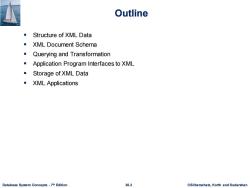
Outline ■Structure of XML Data ■XML Document Schema Querying and Transformation Application Program Interfaces to XML ■Storage of XML Data XML Applications Database System Concepts-7th Edition 30.2 ©Silberscha乜,Korth and Sudarshan
Database System Concepts - 7 30.2 ©Silberschatz, Korth and Sudarshan th Edition Outline ▪ Structure of XML Data ▪ XML Document Schema ▪ Querying and Transformation ▪ Application Program Interfaces to XML ▪ Storage of XML Data ▪ XML Applications

Introduction XML:Extensible Markup Language Defined by the WWConsortium(W3C) Derived from SGML(Standard Generalized Markup Language),but simpler to use than SGML Documents have tags giving extra information about sections of the document E.g.,XML Introduction ... Extensible,unlike HTML Users can add new tags,and separately specify how the tag should be handled for display Database System Concepts-7th Edition 30.3 ©Silberscha乜,Korth and Sudarshan
Database System Concepts - 7 30.3 ©Silberschatz, Korth and Sudarshan th Edition Introduction ▪ XML: Extensible Markup Language ▪ Defined by the WWW Consortium (W3C) ▪ Derived from SGML (Standard Generalized Markup Language), but simpler to use than SGML ▪ Documents have tags giving extra information about sections of the document • E.g., XML Introduction … ▪ Extensible, unlike HTML • Users can add new tags, and separately specify how the tag should be handled for display
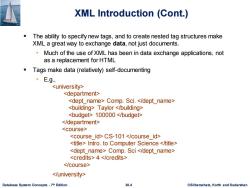
XML Introduction (Cont.) The ability to specify new tags,and to create nested tag structures make XML a great way to exchange data,not just documents. Much of the use of XML has been in data exchange applications,not as a replacement for HTML Tags make data(relatively)self-documenting ·E.g, Comp.Sci. Taylor 100000 CS-101 Intro.to Computer Science Comp.Sci 4 Database System Concepts-7th Edition 30.4 ©Silberscha乜,Korth and Sudarshan
Database System Concepts - 7 30.4 ©Silberschatz, Korth and Sudarshan th Edition XML Introduction (Cont.) ▪ The ability to specify new tags, and to create nested tag structures make XML a great way to exchange data, not just documents. • Much of the use of XML has been in data exchange applications, not as a replacement for HTML ▪ Tags make data (relatively) self-documenting • E.g., Comp. Sci. Taylor 100000 CS-101 Intro. to Computer Science Comp. Sci 4
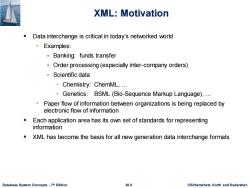
XML:Motivation Data interchange is critical in today's networked world ·Examples: Banking:funds transfer Order processing (especially inter-company orders) Scientific data Chemistry:ChemML,... Genetics:BSML (Bio-Sequence Markup Language),.. 。 Paper flow of information between organizations is being replaced by electronic flow of information Each application area has its own set of standards for representing information XML has become the basis for all new generation data interchange formats Database System Concepts-7th Edition 30.5 ©Silberscha乜,Korth and Sudarshan
Database System Concepts - 7 30.5 ©Silberschatz, Korth and Sudarshan th Edition XML: Motivation ▪ Data interchange is critical in today’s networked world • Examples: ▪ Banking: funds transfer ▪ Order processing (especially inter-company orders) ▪ Scientific data • Chemistry: ChemML, … • Genetics: BSML (Bio-Sequence Markup Language), … • Paper flow of information between organizations is being replaced by electronic flow of information ▪ Each application area has its own set of standards for representing information ▪ XML has become the basis for all new generation data interchange formats
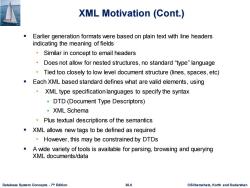
XML Motivation (Cont.) Earlier generation formats were based on plain text with line headers indicating the meaning of fields Similar in concept to email headers ·Does not allow for nested structures,no standard“type”language Tied too closely to low level document structure (lines,spaces,etc) Each XML based standard defines what are valid elements,using XML type specification languages to specify the syntax DTD(Document Type Descriptors) XML Schema Plus textual descriptions of the semantics XML allows new tags to be defined as required However,this may be constrained by DTDs A wide variety of tools is available for parsing,browsing and querying XML documents/data Database System Concepts-7th Edition 30.6 @Silberschatz,Korth and Sudarshan
Database System Concepts - 7 30.6 ©Silberschatz, Korth and Sudarshan th Edition XML Motivation (Cont.) ▪ Earlier generation formats were based on plain text with line headers indicating the meaning of fields • Similar in concept to email headers • Does not allow for nested structures, no standard “type” language • Tied too closely to low level document structure (lines, spaces, etc) ▪ Each XML based standard defines what are valid elements, using • XML type specification languages to specify the syntax ▪ DTD (Document Type Descriptors) ▪ XML Schema • Plus textual descriptions of the semantics ▪ XML allows new tags to be defined as required • However, this may be constrained by DTDs ▪ A wide variety of tools is available for parsing, browsing and querying XML documents/data
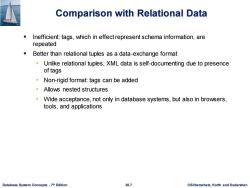
Comparison with Relational Data Inefficient:tags,which in effect represent schema information,are repeated Better than relational tuples as a data-exchange format Unlike relational tuples,XML data is self-documenting due to presence of tags Non-rigid format:tags can be added Allows nested structures Wide acceptance,not only in database systems,but also in browsers, tools,and applications Database System Concepts-7th Edition 30.7 @Silberschatz,Korth and Sudarshan
Database System Concepts - 7 30.7 ©Silberschatz, Korth and Sudarshan th Edition Comparison with Relational Data ▪ Inefficient: tags, which in effect represent schema information, are repeated ▪ Better than relational tuples as a data-exchange format • Unlike relational tuples, XML data is self-documenting due to presence of tags • Non-rigid format: tags can be added • Allows nested structures • Wide acceptance, not only in database systems, but also in browsers, tools, and applications
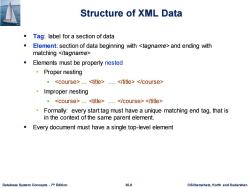
Structure of XML Data Tag:label for a section of data Element:section of data beginning with and ending with matching Elements must be properly nested ·Proper nesting ........ ·Improper nesting ....... Formally:every start tag must have a unique matching end tag,that is in the context of the same parent element. Every document must have a single top-level element Database System Concepts-7th Edition 30.8 ©Silberscha乜,Korth and Sudarshan
Database System Concepts - 7 30.8 ©Silberschatz, Korth and Sudarshan th Edition Structure of XML Data ▪ Tag: label for a section of data ▪ Element: section of data beginning with and ending with matching ▪ Elements must be properly nested • Proper nesting ▪ … …. • Improper nesting ▪ … …. • Formally: every start tag must have a unique matching end tag, that is in the context of the same parent element. ▪ Every document must have a single top-level element
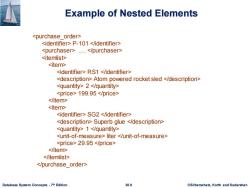
Example of Nested Elements P-101 .... RS1 Atom powered rocket sled 2 199.95 SG2 Superb glue 1 liter 29.95 Database System Concepts-7th Edition 30.9 ©Silberscha乜,Korth and Sudarshan
Database System Concepts - 7 30.9 ©Silberschatz, Korth and Sudarshan th Edition Example of Nested Elements P-101 …. RS1 Atom powered rocket sled 2 199.95 SG2 Superb glue 1 liter 29.95
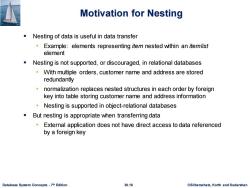
Motivation for Nesting Nesting of data is useful in data transfer Example:elements representing item nested within an itemlist element Nesting is not supported,or discouraged,in relational databases With multiple orders,customer name and address are stored redundantly normalization replaces nested structures in each order by foreign key into table storing customer name and address information Nesting is supported in object-relational databases But nesting is appropriate when transferring data External application does not have direct access to data referenced by a foreign key Database System Concepts-7th Edition 30.10 ©Silberscha乜,Korth and Sudarshan
Database System Concepts - 7 30.10 ©Silberschatz, Korth and Sudarshan th Edition Motivation for Nesting ▪ Nesting of data is useful in data transfer • Example: elements representing item nested within an itemlist element ▪ Nesting is not supported, or discouraged, in relational databases • With multiple orders, customer name and address are stored redundantly • normalization replaces nested structures in each order by foreign key into table storing customer name and address information • Nesting is supported in object-relational databases ▪ But nesting is appropriate when transferring data • External application does not have direct access to data referenced by a foreign key
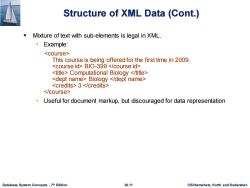
Structure of XML Data (Cont.) Mixture of text with sub-elements is legal in XML. 。 Example: This course is being offered for the first time in 2009 BIO-399 Computational Biology Biology 3 Useful for document markup,but discouraged for data representation Database System Concepts-7th Edition 30.11 ©Silberscha乜,Korth and Sudarshan
Database System Concepts - 7 30.11 ©Silberschatz, Korth and Sudarshan th Edition Structure of XML Data (Cont.) ▪ Mixture of text with sub-elements is legal in XML. • Example: This course is being offered for the first time in 2009. BIO-399 Computational Biology Biology 3 • Useful for document markup, but discouraged for data representation
按次数下载不扣除下载券;
注册用户24小时内重复下载只扣除一次;
顺序:VIP每日次数-->可用次数-->下载券;
- 《数据库系统概念 Database System Concepts》原书教学资源(第七版,PPT课件讲稿,英文版)Chapter 03 Introduction to SQL.pptx
- 《数据库系统概念 Database System Concepts》原书教学资源(第七版,PPT课件讲稿,英文版)Chapter 29 Object-Based Databases.pptx
- 《数据库系统概念 Database System Concepts》原书教学资源(第七版,PPT课件讲稿,英文版)Chapter 28 Advanced Relational Database Design.pptx
- 《数据库系统概念 Database System Concepts》原书教学资源(第七版,PPT课件讲稿,英文版)Chapter 27 Formal-Relational Query Languages.pptx
- 《数据库系统概念 Database System Concepts》原书教学资源(第七版,PPT课件讲稿,英文版)Chapter 26 Blockchain Databases.pptx
- 《数据库系统概念 Database System Concepts》原书教学资源(第七版,PPT课件讲稿,英文版)Chapter 25 Advanced Application Development.pptx
- 《数据库系统概念 Database System Concepts》原书教学资源(第七版,PPT课件讲稿,英文版)Chapter 24 Advanced Indexing.pptx
- 《数据库系统概念 Database System Concepts》原书教学资源(第七版,PPT课件讲稿,英文版)Chapter 23 Parallel and Distributed Transaction Processing.pptx
- 《数据库系统概念 Database System Concepts》原书教学资源(第七版,PPT课件讲稿,英文版)Chapter 22 Parallel and Distributed Query Processing.pptx
- 《数据库系统概念 Database System Concepts》原书教学资源(第七版,PPT课件讲稿,英文版)Chapter 21 Parallel and Distributed Storage.pptx
- 《数据库系统概念 Database System Concepts》原书教学资源(第七版,PPT课件讲稿,英文版)Chapter 20 Database System Architectures.pptx
- 《数据库系统概念 Database System Concepts》原书教学资源(第七版,PPT课件讲稿,英文版)Chapter 02 Intro to Relational Model.pptx
- 《数据库系统概念 Database System Concepts》原书教学资源(第七版,PPT课件讲稿,英文版)Chapter 19 Recovery System.pptx
- 《数据库系统概念 Database System Concepts》原书教学资源(第七版,PPT课件讲稿,英文版)Chapter 18 Concurrency Control.pptx
- 《数据库系统概念 Database System Concepts》原书教学资源(第七版,PPT课件讲稿,英文版)Chapter 17 Transactions.pptx
- 《数据库系统概念 Database System Concepts》原书教学资源(第七版,PPT课件讲稿,英文版)Chapter 16 Query Optimization.pptx
- 《数据库系统概念 Database System Concepts》原书教学资源(第七版,PPT课件讲稿,英文版)Chapter 15 Query Processing.pptx
- 《数据库系统概念 Database System Concepts》原书教学资源(第七版,PPT课件讲稿,英文版)Chapter 14 Indexing.pptx
- 《数据库系统概念 Database System Concepts》原书教学资源(第七版,PPT课件讲稿,英文版)Chapter 13 Data Storage Structures.pptx
- 《数据库系统概念 Database System Concepts》原书教学资源(第七版,PPT课件讲稿,英文版)Chapter 12 Physical Storage Systems.pptx
- 《数据库系统概念 Database System Concepts》原书教学资源(第七版,PPT课件讲稿,英文版)Chapter 31 Information Retrieval.pptx
- 《数据库系统概念 Database System Concepts》原书教学资源(第七版,PPT课件讲稿,英文版)Chapter 04 Intermediate SQL.pptx
- 《数据库系统概念 Database System Concepts》原书教学资源(第七版,PPT课件讲稿,英文版)Chapter 05 Advanced SQL.pptx
- 《数据库系统概念 Database System Concepts》原书教学资源(第七版,PPT课件讲稿,英文版)Chapter 06 Database Design Using the E-R Model.pptx
- 《数据库系统概念 Database System Concepts》原书教学资源(第七版,PPT课件讲稿,英文版)Chapter 07 Normalization.pptx
- 《数据库系统概念 Database System Concepts》原书教学资源(第七版,PPT课件讲稿,英文版)Chapter 08 Complex Data Types.pptx
- 《数据库系统概念 Database System Concepts》原书教学资源(第七版,PPT课件讲稿,英文版)Chapter 09 Application Development.pptx
- 计算机科学与技术教学资源(参考文献)The generalized Cholesky factorization method for saddle point problems.pdf
- 计算机科学与技术教学资源(参考文献)Inverse updating and downdating for weighted linear least squares using M-invariant reflections.pdf
- 计算机科学与技术教学资源(参考文献)Analysis of peaks and plateaus in a Galerkin/minimal residual pair of methods.pdf
- 计算机科学与技术教学资源(参考文献)Perturbation analysis for the generalized Cholesky factorization.pdf
- 计算机科学与技术教学资源(参考文献)STABILITY OF THE MATRIX FACTORIZATION FOR SOLVING BLOCK TRIDIAGONAL SYMMETRIC INDEFINITE LINEAR SYSTEMS.pdf
- 计算机科学与技术教学资源(参考文献)A Convergent Restarted GMRES Method For Large Linear Systems.pdf
- 计算机科学与技术教学资源(参考文献)Properties and Computations of Matrix Pseudospectra.pdf
- 计算机科学与技术(参考文献)A Novel Constrained Texture Mapping Method Based on Harmonic Map.pdf
- 计算机科学与技术(参考文献)A Robust and Fast Non-local Algorithm for Image Denoising.pdf
- 计算机科学与技术(参考文献)Efficient View Manipulation for Cuboid-Structured Images.pdf
- 计算机科学与技术(参考文献)Ensemble of trusted firmware services based on TPM.pdf
- 计算机科学与技术(参考文献)Fuzzy Quantization Based Bit Transform for Low Bit-Resolution Motion Estimation.pdf
- 计算机科学与技术(参考文献)Image Completion based on Views of Large Displacement.pdf
